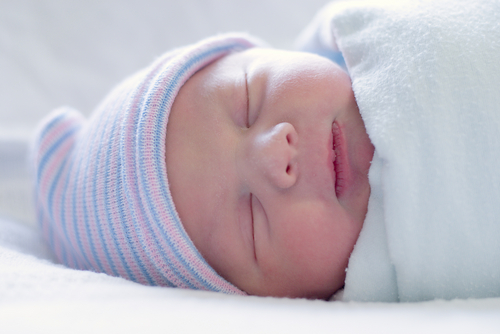Sleep is an elusive goal for anyone who is caring for a newborn. Between around-the-clock feedings, diaper changes, visitors and housework, sleep can seem like a mirage in the desert. But by adopting these tried-and-true strategies, you can help the baby get more sleep, which translates to much-needed shuteye for yourself.
Swaddle for Security
During baby’s first three months in the world, simulating the warm and cozy womb environment by swaddling can be one of the most effective ways to soothe little ones to sleep. The close wrap of a swaddle can provide the feeling of close contact that the baby was accustomed to in utero, while also helping to prevent newborns from startling themselves awake due to an active Moro reflex. When swaddled correctly using a lightweight blanket, this strategy alone can help newborns sleep for longer durations.
Consult a pediatrician to learn the recommended swaddling techniques or use a swaddle like those from SwaddleDesigns, which have instructions sewn into each blanket. To ensure maximum comfort and safety when swaddling, avoid dressing the baby in heavy clothing underneath the swaddle. Instead of footed pajamas, a bodysuit is often sufficient, depending on the weight of the blanket and the temperature in the home. It is essential to periodically check baby by touching and feeling baby’s stomach to ensure baby is not too hot (sweaty) or too cold (stomach feels cool to touch). Baby should feel comfortably warm. And always place baby on his or her back for nighttime and naptime sleep.
Soothing Sounds
After spending nine months in the womb surrounded by amniotic fluid, babies are used to hearing muffled noise around the clock. Help soothe your baby by easing into this new environment with white noise during day and night sleep. Continuous playing of soothing white noise such as ocean waves, a heart beating or a running stream can help newborns fall asleep. A landmark British study found that 80 percent of newborn babies listening to white noise fell asleep within five minutes, while only 25 percent of babies fell asleep within the same time frame without the white noise.
White noise machines have received some criticism lately, with critics contending that machines are too loud and may damage hearing. However, as long as you keep the volume at a reasonable level, this should not be a concern, pediatrician Dr. Harvey Karp wrote in his book, “The Happiest Baby on the Block.”
Keep It Dark
Complete darkness is helpful for both night sleep as well as daytime naps. Install blackout window shades in any room where the baby sleeps regularly to provide better light regulation. Darkness triggers the release of the sleep hormone melatonin, according to sleep researchers at Stanford. By contrast, the presence of light, even in the smallest amount, can inhibit the release of melatonin and make it more difficult to fall asleep or stay asleep.
In addition to using blackout shades, make sure there isn’t any other type of light visible in the room. Do not use a nightlight and be sure that your white noise machine is not contributing any light pollution when in use.
